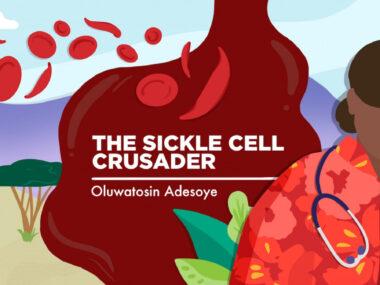Here’s what we can do for National Sickle Cell Awareness Month
This September, let's continue to make progress for the sickle cell community
Written by |

For the sickle cell disease community, September is an important time for advocacy and raising awareness, because it’s National Sickle Cell Awareness Month. This year’s theme is “Sickle Cell Matters.”
For me, the month isn’t only about raising awareness; it’s also about educating the public, advocating for better healthcare, and creating meaningful change that improves the lives of people with this disease.
There are four areas of action I’d like to see this month: education, healthcare, research and funding, and community.
Education starts with understanding that sickle cell is a genetic blood disorder that affects millions of people around the world. While it predominantly affects people of African descent, it’s not exclusive to this group, which is a common misconception. Many people misunderstand the disease in other ways, too.
This awareness month, I’d love to see more of the general public educate themselves about the disease and figure out ways to support our community. In London, where I’m from, several events are taking place with this idea in mind. Other events are happening globally. Check with your local sickle cell charities to see what tools they offer to educate people about this condition.
In terms of healthcare, one of the most challenging realities I’ve faced is being in a hospital where the staff doesn’t know how to take care of me. Some healthcare providers lack adequate knowledge about sickle cell disease. This can lead to misdiagnosis, delayed treatment, and a general lack of empathy and understanding for those living with the condition.
All of the sickle cell patients I’ve had the pleasure of meeting have told me about times when medical professionals have either misunderstood or dismissed their pain crises. By dedicating an entire month to raising awareness, we can work toward changing this narrative and ensuring that healthcare providers are better equipped to recognize and treat sickle cell effectively.
Step up the funding
Despite the significant burden that sickle cell disease places on patients and healthcare systems in general, research into new treatments and potential cures has been historically underfunded. This lack of investment is partly because sickle cell disease primarily affects marginalized communities that often have less political and economic power to advocate for themselves. Working in research has shown me that there are vast amounts of studies out there on the most niche medical conditions. But sickle cell disease doesn’t seem to be a priority.
Through coordinated awareness efforts this month, we can draw attention to the disparities in research funding and push for more to be allocated to sickle cell disease. More research and funding are fundamental because we are on the brink of significant breakthroughs in gene therapy and other innovative treatments that could potentially benefit our community.
And speaking of community, this month reminds us of the importance of community support. Living with sickle cell disease can be incredibly isolating. But during this month, advocacy groups, healthcare organizations, and community leaders come together to host events, share stories, and provide resources for those affected by the disease.
These activities help to build a sense of community among people with sickle cell and to educate the broader public. The stories that are shared help to put a human face on the disease, moving it from simply a clinical diagnosis to a broader understanding of the daily struggles and triumphs of those who live with it.
With all of this in mind, it’s also a time to celebrate the resilience and strength of our community. Despite the challenges we face, we continue to push for success, pursue our dreams, and contribute to society in meaningful ways. By highlighting these stories of resilience, we can change the narrative around sickle cell disease, focusing not only on the pain and the hardship, but also on the incredible spirit of those who live with it.
Through increased awareness and understanding, we can work toward a future when sickle cell disease is no longer a neglected condition but rather one that receives the attention, funding, support, and care it deserves. This month, I urge everyone to turn awareness into action, which will lead to better lives for all of us with sickle cell disease and, one day, a cure.
Note: Sickle Cell Disease News is strictly a news and information website about the disease. It does not provide medical advice, diagnosis, or treatment. This content is not intended to be a substitute for professional medical advice, diagnosis, or treatment. Always seek the advice of your physician or other qualified health provider with any questions you may have regarding a medical condition. Never disregard professional medical advice or delay in seeking it because of something you have read on this website. The opinions expressed in this column are not those of Sickle Cell Disease News or its parent company, Bionews, and are intended to spark discussion about issues pertaining to sickle cell disease.







Hi Mary Murph
I would like to applaud Bionews for featuring such excellent writers who are writers. They are educated, informative, while constantly battling a war of pain that no one except warriors can identify with. Please be encouraged, and know that your articles are helping to educate multiplicity of people. Thank you!🙏🏽
Lorna Tucker
SICKLE CELL TRAIT
I am in my 60s and I am just becoming aware...
1. If you carry the sickle cell gene you are prone to clotting as your arteries may get clogged.
2. Vit B12 is essential but Vit Bs in general to make those precious red blood cells.
3. Strenuous exercise (the lungs have to work harder).
4. The text books will say this - avoid high altitudes, where the air is thin and extremes of temperature.
5. I don't know the genetics on this but your body may see certain foods as alien and attack (so your own body attack you as it would the mosquito venom).
6. You may be prone to joint and muscle wastage, & bloatedness (sickle cell tummy).
This is for anyone experiencing symptoms like pain in the legs, circulation issues, sleep apnoea (pain in the chest, brain fog, headaches and fatigue) and you have the gene. Now you can alert your GP and get the right treatment and also for school age children, the schools need to know.
Oh, we may need our nap in the afternoon too.
Marina Thorpe
This article is so detailed and informative, it truly captures the realities of living with Sickle Cell. As a sickle cell champion myself, I have been raising awareness here in The Gambia 🇬🇲. I couldn’t agree more that more research and studies are urgently needed, as living with sickle cell can be extremely difficult, especially for those who face severe challenges.
What saddens me is that despite all the awareness and advocacy done year after year, the response from governments, communities, healthcare systems, schools, and workplaces still falls short of giving this condition the attention it deserves. The severity of sickle cell continues to be overlooked, and that is disheartening.
I remain hopeful, however, that change will come soon and that sickle cell will finally receive the recognition and support it needs.